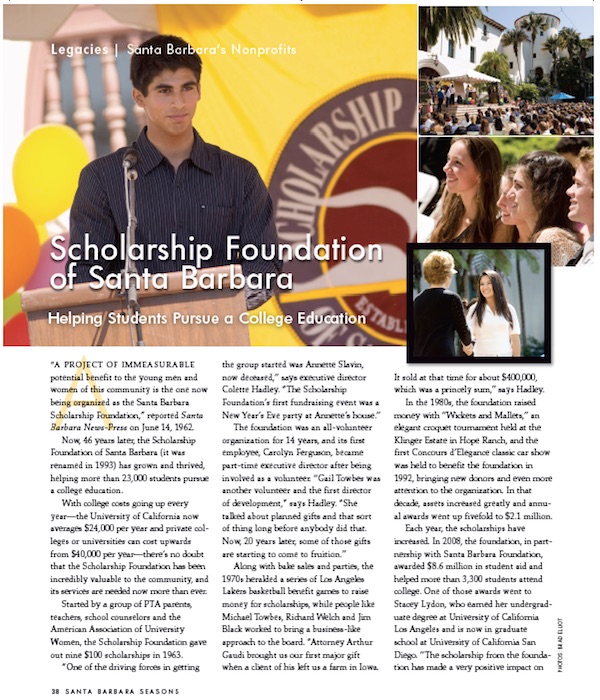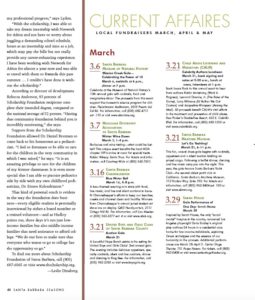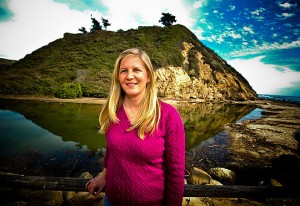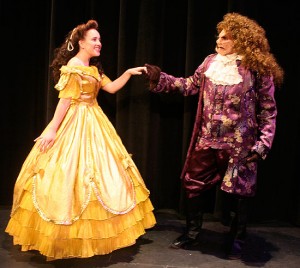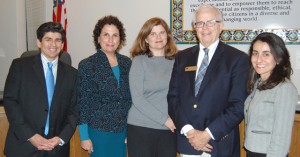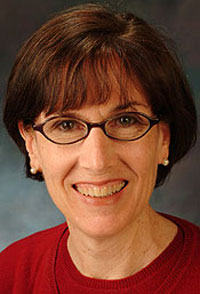
Nancy Harter, courtesy photo
After eight years of service of service on the Santa Barbara School Board, Nancy Harter has earned some reflection time. She talks about what it was like to sit on the board, and what she has planned for the future.
Leslie Dinaberg: How did you get interested in running for school board?
Nancy Harter: In March of 2000 when the secondary bond (a $67 million bond to
improve the infrastructure and modernization of aging campuses)
was on the ballot, Irene Falzone and I co-chaired the campaign. She was a
Santa Barbara High parent at the time; I was a Dos Pueblos parent. Once I got
through that election I started to become a regular at board meetings, then I
decided to run in November.
LD: Are your kids out of the school system now?
NH: Yes, long since. People run who don’t currently have kids in the system and
I think that they can do a terrific job, but for me, a big part of being on the school
board was having that network and knowing at least a couple of staff members
on every single campus and on some campuses knowing a lot of the staff
members, so when issues would come up you had people to call, people to
network with and find out what would be the impact would be on the school.
LD: I think you get less agenda-driven information if you’re calling them as
someone that you’ve known for a while, as opposed to as a board
member.
NH: Right, for me it made a big difference. Actually one of my favorite columns of
yours was the one about going to the PTA meetings because that’s what
happens, you start going to the PTA meetings, you take on more and more
responsibility, the next thing you know you’re the president and then low and
behold, the next thing you know you’re running for school board.
LD: The whole thing has been interesting to me because I started covering
school issues before my son was in school. My perspective definitely changed
having been involved on the inside.
NH: Yes, your perspective changes. You personally have a lot more invested and
there’s just that unbelievable personal connection.
LD: That probably gives you a good insight too.
NH: I think it did. My kids attended the Goleta Elementary Schools but for
secondary, I was a secondary parent from 1992 until 2005, so for 13
years.
LD: Were you ready to be done?
NH: I wouldn’t say that, because there are still issues simmering on the stove
that I would really like to be a part of but, you know, better to leave a day early
than a day late was how I felt about it. I really was not anxious to do another
campaign. Sort of the upside and the downside of school boards in Santa
Barbara is that really good people always run, but it’s an election. You can’t just
assume that you’ll be able to retain your seat without running a
campaign.
LD: What were some of the highlights of your school board experience?
NH: … A big part of it was building relationships, creating a bigger network,
creating relationships with other agencies. The City of Santa Barbara for
instance, we’ve got a great relationship with them now and it was virtually non-
existent when I came on to the board.
… Another big piece for me was the whole paying it forward sort of piece. When I
came on to the board it was a great board-Fred Rifkin, Claire Van Blaricum,
Bob Noel, Steve Forsell-and Claire really helped me with my campaign and
mentored me as a new board member. I took that responsibility really seriously,
so there wasn’t a single election cycle that went by in my eight years where I
didn’t encourage somebody to run, help them with their campaign and then help
them get started on the board.
LD: Are you going to stay involved in local politics or local school issues?
NH: For me it’s about educational policy. I’m not interested in running for
anything else, I’m really happy to be involved in the nonprofit world and efforts
surrounding the schools but I don’t think I’ll ever run for anything again. (Laughs)
It’s a really different skill set to put yourself out there and sell yourself to
somebody with that tape running in your head of your mother saying that the
least interesting topic of conversation is yourself, it’s just hard to put yourself out
there. But I find it very easy to work with other people and collaborate with other
people over issues to come to resolution. I’m not a natural born campaigner,
that’s for sure.
LD: When we scheduled this interview I thought it would be completely non-
controversial, but I did read your op-ed piece in Noozhawk and I have to ask you
about the Bob Noel editorial. Why did you finally write that?
NH: You know, I’m not interested in rehashing it. I stand by what I said and I
don’t need to keep beating the drum. It really had to do with calling for the
superintendent’s resignation and then not participating in the process. … it was
more about the method than about the message.
LD: Is there anything you wish you would have said or done differently in
retrospect?
NH: … I’m not a regretful person, so I would say no. I think I worked really hard
to keep a high level of discourse, and that was the kind of board that I came on
to, and I think I succeeded.
LD: So what’s next?
NH: I have always been involved in the nonprofit world and I’m taking on some
new nonprofit responsibilities and I would just really like to pour myself into that in
the short term and then see how things play out. There’s no grand plan in place.
You acquire this incredible body of knowledge about educational policy and then
you go off the board and it’s like, so now where do I take this? So hopefully there
will be some opportunities that allow me to tap into that expertise, but I don’t
know what they are yet.
LD: Do you have any advice for anyone considering local public office?
NH: I think a lot of people don’t run because they think that as a school board
member that you have some sort of legacy building obligation, that somehow you
need to create some new program or accomplish some grand achievement and I
really think that that is a mistake. I think that you can build a legacy by coming
really well prepared to every single school board meeting, by talking to your
friends and neighbors about issues and getting different opinions. I don’t think it
has to be something physical left behind when you’re done with your
term.
I think that there are a lot of really smart capable people out there who have a
really passionate interest in schools and then talk themselves out of it. And we’re
lucky in this area in Santa Barbara and in all of our surrounding school districts;
there are a lot of really smart people who are willing to run for school board. But
you know I don’t think that people should be, certainly they shouldn’t be scared
away by the issues. You know you’re involved in group think, you’re problem
solving with other people, the burden isn’t solely on you. But also, I think people
get scared away when they read in the paper about the occasional inflammatory
public comment and that’s not every board meeting.
LD: I would imagine you would have to get used to that somewhat too, not that it
would ever become easy.
NH: Well if you have a good internal compass you know which public comments
to pay attention and to take to heart, and you know which to just flip the switch
and just not pay any attention.
… I think we’re lucky, especially in the secondary district, we’re one of the few
areas where everybody takes advantage of the public school system with a
handful of exceptions and I think the secondary is one of those school districts
where you probably have the biggest group of haves and have nots who come
together every school day. And that doesn’t happen in a lot of communities.
… When you have a really bad night at a school board meeting, the best antidote
is to get to a school campus some time before the end of the week because the
energy is just unbelievable on any of the campuses. I really like it.
Vital Stats: Nancy Harter
Born: San Francisco, April 29, 1953
Family: Husband Larry; daughter Anne, age 28; son Jake, age 25; and daughter
Julia age 21.
Civic Involvement: Santa Barbara School Board; Santa Barbara Education
Foundation; Future leaders of America, Berkeley Alumni Association’s
Achievement Award Program; joining the Planned Parenthood Action Fund in
January.
Professional Accomplishments: Eight years on the Santa Barbara School Board;
Masters Degree in English, taught freshman English at the University of
Nebraska; has a law degree but never practiced law. “My oldest was born my
third year of law school, so my involvement in the world has almost always been
nonprofits.”
Best Book You’ve Read Recently: Mountains Beyond Mountains: The Quest of
Dr. Paul Farmer, a Man Who Would Cure the World, by Tracy Kidder, but I
usually read fiction.
Originally published in Noozhawk on February 29, 2008.



